Papers by Jacob Scharcanski
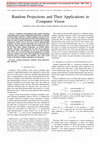
Proceedings of XXXIV Simpósio Brasileiro de Telecomunicações e Processamento de Sinais - SBrT 2016
— Computer vision problems often require extracting and handling large volumes of high dimensiona... more — Computer vision problems often require extracting and handling large volumes of high dimensional data. Commonly, a dimensionality reduction is initially applied to project the features representing the input data into lower dimensionality spaces before its analysis and/or classification. Techniques like Principal Component Analysis (PCA) have been used for dimensionality reduction, but data structure distortions may result from these projections, often leading to analysis and/or classification errors. On the other hand, random projections can provide dimen-sionality reduction while preserving the data local properties, and sample relative inter-distances in the lower dimensionality space. We review some of the theoretical foundations of random projection methods, and discuss their application in dimensional reduction and in computer vision problems. Also, some recent trends in the field of random projections are discussed.
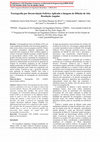
Resumo: A tractografia por tensor de difusão (DTI) vem sendo amplamente utilizada como ferramenta... more Resumo: A tractografia por tensor de difusão (DTI) vem sendo amplamente utilizada como ferramenta qualitativa, tanto na área clínica como em pesquisa científica. Porém, o modelo matemático utilizado tipicamente não representa bem conjuntos de fibras cerebrais quando se cruzam. O presente trabalho investiga o modelo baseado na deconvolução esférica (CSD) como alternativa ao modelo DTI para resolver o problema de cruzamento de fibras cerebrais. Para tanto, foi revisada parte da literatura disponível, implementado um protocolo de aquisição de imagens de ressonância magnética de alta resolução angular ponderadas em difusão (HARDI), e discutidos os resultados alcançados neste estudo em comparação com outros estudos. Concluiu-se que o protocolo proposto para aquisição de imagens HARDI, bem como a metodologia de processamento adotada, são apropriadas para a reconstrução da tractografia por deconvolução esférica. Abstract: Diffusion Tensor Tractography has been widely used as a qualitative tool since its origin in clinical and research domain. However, this model doesn't robustly represent crossing fiber bundles. The current study investigates the Constrained Spherical Deconvolution model (CSD) as an alternative to the Diffusion Tensor model in order to solve the crossing fibers problem. Aiming this purpose, a brief review of the available literature was made. A protocol for acquiring High Angular Resolution Diffusion Images (HARDI) was implemented and results were compared to other studies. We conclude that the proposed protocol for acquiring HARDI data, as well as the embraced pipeline for processing these images are proper for CSD tractography reconstruction.
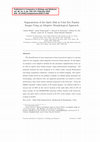
The identification of some important retinal anatomical regions is a prerequisite for the compute... more The identification of some important retinal anatomical regions is a prerequisite for the computer aided diagnosis of several retinal diseases. In this paper, we propose a new adaptive method for the automatic segmentation of the op-tic disk in digital color fundus images, using mathematical morphology. The proposed method has been designed to be robust under varying illumination and image acquisition conditions, common in eye fundus imaging. Our experimental results based on two publicly available eye fundus image databases are encouraging, and indicate that our approach potentially can achieve a better performance than other known methods proposed in the literature. Using the DRIVE database (which consists of 40 retinal images), our method achieves a success rate of 100% in the correct location of the optic disk, with 41.47% of mean overlap. In the DIARETDB1 database (which consists of 89 retinal images), the optic disk is correctly located in 97.75% of the images, with a mean overlap of 43.65%.
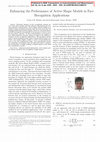
—Biometric features in face recognition systems are one of the most reliable and least intrusive ... more —Biometric features in face recognition systems are one of the most reliable and least intrusive alternatives for personal identity authentication. Active Shape Model (ASM) is an adaptive shape matching technique that has been used often for locating facial features in face images. However, the performance of ASM can degrade substantially in the presence of noise or near the face frame contours. In this correspondence, we propose a new ASM landmark selection scheme to improve the ASM performance in face recognition applications. The proposed scheme selects robust landmark points where relevant facial features are found, and assigns higher weights to their corresponding features in the face classification stage. The experimental results are promising, and indicate that our approach tends to enhance the performance of ASM, leading to improvements in the final face classification results.
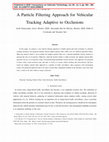
In this paper, we propose a new particle filtering approach to handle partial and total occlusion... more In this paper, we propose a new particle filtering approach to handle partial and total occlusions in vehicular tracking situations. Our proposed method, named adaptive particle filter (APF), uses two different operation modes. When the tracked vehicle is not occluded, the adaptive particle filter uses a Normal probability density function to generate the new set of particles. Otherwise, when the tracked vehicle is under occlusion, the adaptive particle filter generates the new set of particles using a Normal-Rayleigh probability density function. Our approach was designed to detect when a total occlusion starts and ends, as well as to resume vehicle tracking after disocclusions. We have tested our adaptive particle filter approach in a number of traffic surveillance video sequences with encouraging results. Our proposed approach tends to be more accurate than comparable methods in the literature, and at the same time, it tends to be more robust to target occlusions.
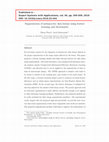
Pre-screening systems for the diagnosis of melanocytic skin lesions depend of the proper segmenta... more Pre-screening systems for the diagnosis of melanocytic skin lesions depend of the proper segmentation of the image region affected by the lesion. This paper proposes a feature learning scheme that finds relevant features for skin lesion image segmentation. This work introduces a new unsupervised dictionary learning method, namely Unsupervised Information-Theoretic Dictionary Learning (UITDL), and discusses how it can be applied in the segmentation of skin le-sions in macroscopic images. The UITDL approach is adaptive and tends to be robust to outliers in the training data, and consists of two main stages. In the first stage, a textural variation image is used to construct an initial feature dictionary and an initial sparse representation via Non-Negative Matrix Fac-torization (NMF). In the second stage, the feature dictionary is optimized by selecting adaptively the number of dictionary atoms. The greedy approach used for dictionary optimization is quite efficient and flexible enough to be applied to other dictionary learning problems. Furthermore, the proposed method can be easily extended for other image segmentation problems. The experimental results suggest that the proposed approach potentially can provide more accurate skin lesion segmentation results than comparable state-of-the-art methods. The proposed segmentation method could help to improve the performance of pre-screening systems for melanocytic skin lesions, which can affect positively the quality of the early diagnosis provided to skin lesion patients.
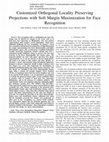
—Face recognition still is a challenging task since face images may be affected by changes in the... more —Face recognition still is a challenging task since face images may be affected by changes in the scene, such as in head pose, face expression, or illumination. Also, face pattern representation often requires several dimensions, which poses additional challenges for face recognition. We propose a novel face recognition method based on projections of high dimensional face image representations into lower dimensionality and highly discriminative spaces. This is achieved by a modified Orthogonal Locality Preserving Projections (OLPP) method, that uses a customized locality definition scheme to preserve the face class structure in the lower dimensionality face feature space. The proposed method can work with sparse and dense face image representations (i.e. it can use subsets or all face image pixels), and tends to be robust to data outliers and noise. Besides, we introduce a sparse representation using interpolated landmarks, designed to preserve important details in high resolution color face images (e.g. eyes), and compensate for uncertainties in landmark positioning during face image feature extraction. The face images are classified in this lower dimensionality feature space using a trained soft margins Support Vector Machine (SVM), so it performs better than the nearest neighbor rule used in the typical OLPP method. A set of experiments was designed to evaluate the proposed scheme under various conditions found in practice (such as changes in head pose, face expression, illumination, and in the presence of occlusion artifacts). The experimental results were obtained using five challenging public face databases (namely, PUT, FEI, FERET, Yale and ORL). These experiments suggest that our sparse representation for high resolution face color images, integrated to the proposed lower dimensionality feature space and classification scheme, tends to obtain higher accuracy values than those obtained using typical sparse and dense representations for the same face images in grayscale. To evaluate the generality of our lower dimensionality feature space and classification scheme, additional tests using full low resolution grayscale face images were performed, as often used in face recognition (e.g. typical OLPP method). Our experiments suggest that the proposed approach also can provide higher accuracy values than comparable state-of-the-art methods available in the literature, when using full low resolution grayscale face images (i.e. dense representations).
Abstract—This paper discusses an approach for detecting edges in color
images. A color image is r... more Abstract—This paper discusses an approach for detecting edges in color
images. A color image is represented by a vector field, and the color
image edges are detected as differences in the local vector statistics. These statistical differences can include local variations in color or spatial image properties. The proposed approach can easily accommodate concepts, such as multiscale edge detection, as well as the latest developments in vector order statistics for color image processing. A distinction between the proposed approach and previous approaches for color edge detection using vector order statistics is that, besides the edge magnitude, the local edge direction is also provided. Note that edge direction information is a relevant feature to a variety of image analysis tasks (e.g., texture analysis) .
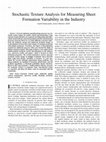
—Several continuous manufacturing processes use sto-chastic texture images for quality control an... more —Several continuous manufacturing processes use sto-chastic texture images for quality control and monitoring. Large amounts of pictorial data are acquired, providing important information about both the materials produced and the manufacturing processes involved. However, it is often difficult to measure objectively the similarity among such industrial stochastic images or to discriminate between the texture images of stochastic materials with distinct properties. Nowadays, the degree of discrimination required by industrial processes often goes beyond the limits of human visual perception. This paper proposes a new approach for multiresolution stochastic texture discrimination in the industry (e.g., nonwoven textiles and paper), which is focused on sheet formation properties. The wavelet transform is used to represent stochastic texture images in multiple resolutions and to describe them using local density variability as features. At each resolution , the wavelet subbands approximate image gradients. The image gradients are modeled as Gaussian colored noise, and the gradient magnitudes, as Rayleigh probability density functions. Based on this representation, a multiresolution distance measure for stochastic textures is proposed. Some experimental results are reported, and ideas for future work are presented with the conclusions.
—A new image analysis technique is proposed for the evaluation of local anisotropy and its variab... more —A new image analysis technique is proposed for the evaluation of local anisotropy and its variability in stochastic texture images. It utilizes the gradient function to provide information on local anisotropy, from two-dimensional (2-D) density images for foil materials like polymer sheets, nonwoven textiles, and paper. Such images can be captured by radiography or light-transmission ; results are reported for a range of paper structures, and show that the proposed technique is more robust to unfavorable imaging conditions than other approaches. The method has potential for on-line application to monitoring and control of anisotropy and its variability, as well as local density itself, in continuous manufacturing processes.
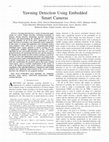
— Yawning detection has a variety of important applications in a driver fatigue detection, well-b... more — Yawning detection has a variety of important applications in a driver fatigue detection, well-being assessment of humans, driving behavior monitoring, operator attentiveness detection, and understanding the intentions of a person with a tongue disability. In all of the above applications, an automatic detection of yawning is one important system component. In this paper, we design and implement such automatic system, using computer vision, which runs on a computationally limited embedded smart camera platform to detect yawning. We use a significantly modified implementation of the Viola–Jones algorithm for face and mouth detections and, then, use a back-projection theory for measuring both the rate and the amount of the changes in the mouth, in order to detect yawning. As proof-of-concept, we have also implemented and tested our system on top of an actual smart camera embedded platform, called APEX from CogniVue Corporation. In our design and implementations, we took into consideration the practical aspects that many existing works ignore, such as real-time requirements of the system, as well as the limited processing power, memory, and computing capabilities of the embedded platform. Comparisons with existing methods show significant improvements in the correct yawning detection rate obtained by our proposed method. Index Terms— Embedded vision algorithm, low complexity detection, smart camera, vision-based measurement (VBM), yawning detection.
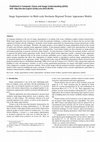
An ongoing challenge in the area of image segmentation is in dealing with scenes exhibiting compl... more An ongoing challenge in the area of image segmentation is in dealing with scenes exhibiting complex textural characteristics. While many approaches have been proposed to tackle this particular challenge, a related topic of interest that has not been fully explored for dealing with this challenge is stochastic texture models, particularly for characterizing textural characteristics within regions of varying sizes and shapes. Therefore, this paper presents a novel method for image segmentation based on the concept of multi-scale stochastic regional texture appearance models. In the proposed method, a multi-scale representation of the image is constructed using an iterative bilateral scale space decomposition. Local texture features are then extracted via image patches and random projections to generate stochastic texture features. A texton dictionary is built from the stochastic features, and used to represent the global texture appearance model. Based on this global texture appearance model, a regional texture appearance model can then be obtained based on the texton occurrence probability given a region within an image. Finally, a stochastic region merging algorithm that allows the computation of complex features is presented to perform image segmentation based on proposed regional texture appearance model. Experimental results using the BDSD300 segmentation dataset showed that the proposed method achieves a Probabilistic Rand Index (PRI) of 0.83 and an F-measure of 0.77@(0.92, 0.68), and provides improved handling of color and luminance variation, as well as strong segmentation performance for images with highly textured regions when compared to a number of previous methods. These results suggest that the proposed stochastic regional texture appearance model is better suited for handling the texture variations of natural scenes, leading to more accurate segmentations, particularly in situations characterized by complex textural characteristics.
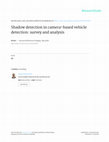
The number of vehicles in circulation in modern urban centers has greatly increased, which motiva... more The number of vehicles in circulation in modern urban centers has greatly increased, which motivates the development of automatic traffic monitoring systems. Consequently, camera-based traffic monitoring systems are becoming more used widely, since they offer important technological advantages in comparison with traditional traffic monitoring systems (e.g. simpler maintenance and more flexibility for the design of practical configurations). The segmentation of the foreground (i.e. vehicles) is a fundamental step in the workflow of a camera-based traffic monitoring system. However, foreground segmentation can be negatively affected by vehicles shadows. This paper discusses the types of shadow detection methods available in the literature, their advantages, disadvantages and in which situations these methods can improve camera-based vehicle detection for traffic monitoring. In order to compare the performance of these different types of shadow detection methods, experiments are conducted with typical methods of each category using publicly available datasets. This work shows that shadow detection definitely can improve the reliability of traffic monitoring systems, but the choice of the type of shadow method depends on the system specifications (e.g. tolerated error), the availability of computational resources and prior information about the scene and its illumination in regular operation conditions.
Visual Communications and Image Processing '92, 1992
This paper analyzes the problem of representing the structural aspect of texture images. To repre... more This paper analyzes the problem of representing the structural aspect of texture images. To represent a texture image, we propose an ensemble composed of feature boundaries detected by multi-scale operators. This ensemble is built by the integration of the detected boundaries in different scales. Using this representation, textures may be discriminated by a simple similarity measure. 156 ISPIE Vol. 1818 Visual Communications and Image Processing '92 O-8194-1018-7/92/$4.OO Downloaded From: http://spiedigitallibrary.org/ on 04/01/2015 Terms of Use: http://spiedl.org/terms SPIE Vol. 1818 Visual Communications and Image Processing '92 / 157 Downloaded From: http://spiedigitallibrary.org/ on 04/01/2015 Terms of Use: http://spiedl.org/terms
2012 IEEE International Conference on Systems, Man, and Cybernetics (SMC), 2012
Active shape models is an adaptive shape-matching technique that has been used for locating facia... more Active shape models is an adaptive shape-matching technique that has been used for locating facial features in images. However, when a number of features is extracted for each landmark point, distortions caused by noise or illumination, and the dimensionality of the final representation, have a negative impact in the performance of a classifier. In this paper, an evolutionary wrapper for selection of the most relevant set of features for face recognition is presented. The proposed strategy explores the space of multiple feasible selections using genetic algorithms. Experimental results show that the proposed approach allows to improve the classification performance in comparison with another enhanced method and a state of the art face recognition approach.
2012 Ieee International Conference on Systems Man and Cybernetics, Oct 1, 2012
Active shape models is an adaptive shape-matching technique that has been used for locating facia... more Active shape models is an adaptive shape-matching technique that has been used for locating facial features in images. However, when a number of features is extracted for each landmark point, distortions caused by noise or illumination, and the dimensionality of the final representation, have a negative impact in the performance of a classifier. In this paper, an evolutionary wrapper for selection of the most relevant set of features for face recognition is presented. The proposed strategy explores the space of multiple feasible selections using genetic algorithms. Experimental results show that the proposed approach allows to improve the classification performance in comparison with another enhanced method and a state of the art face recognition approach.
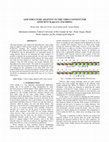
2010 IEEE International Conference on Image Processing, 2010
This paper presents a new method for high efficiency video coding using an adaptive GOP structure... more This paper presents a new method for high efficiency video coding using an adaptive GOP structure based on video content for the H.264/AVC standard. The available H.264/AVC encoders typically use static GOP sizes that define how the frames I (Intra), P (Predictive) and B (Bi-predictive) are positioned during de coding process. However, by analyzing the video content it is possible to identify the optimum position for each type of frame inside the GOP. The proposed method analyses the video content and finds the best position for inserting I frames in the video sequence. Thus the GOP structure can assume different sizes, depending on the video content. The results for test sequences and real videos show that the proposed method can significantly reduce the required bit rate, comparing to the static GOP sizes, with reduced PSNR losses. The proposed adaptive GOP presents a gain, in terms of bit rate reduction for real movies, of 8.6%, 15%, 24.7% and 40.8% in comparison with static GOP sizes 32, 16, 8 and 4, respectively.
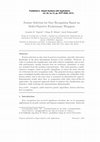
Expert Systems with Applications, 2013
Feature selection is a key issue in pattern recognition, specially when prior knowledge of the mo... more Feature selection is a key issue in pattern recognition, specially when prior knowledge of the most discriminant features is not available. Moreover, in order to perform the classification task with reduced complexity and acceptable performance, usually features that are irrelevant, redundant, or noisy are excluded from the problem representation. This work presents a multiobjective wrapper, based on genetic algorithms, to select the most relevant set of features for face recognition tasks. The proposed strategy explores the space of multiple feasible selections in order to minimize the cardinality of the feature subset, and at the same time to maximize its discriminative capacity. Experimental results show that, in comparison with other state-of-the-art approaches, the proposed approach allows to improve the classification performance, while reducing the representation dimensionality.
doi.ieeecomputersociety.org
Adelailson Peixoto, Universidade Federal de Alagoas, Brazil Adilson Gonzaga, Universidade de S�o ... more Adelailson Peixoto, Universidade Federal de Alagoas, Brazil Adilson Gonzaga, Universidade de S�o Paulo, Brazil Agma Traina, Universidade de S�o Paulo, Brazil Alberto Del Bimbo, Universit� di Firenze, Italy Alceu Britto Jr., Pontif�cia Universidade Cat�lica do Paran�, Brazil Aldo von Wangenheim, Universidade Federal de Santa Catarina, Brazil Aleix Martinez, Ohio State University, USA Alejandro Frery, Universidade Federal de Alagoas, Brazil Alessandro Koerich, Pontif�cia Universidade Cat�lica do Paran�, Brazil Alexandre Falc�o, Unicamp, ...
ieeexplore.ieee.org
Afonso Paiva Neto Alan Chalmers Alejandro Frery Alessandro Bicho Alex Quadros Vargas Alex Laier B... more Afonso Paiva Neto Alan Chalmers Alejandro Frery Alessandro Bicho Alex Quadros Vargas Alex Laier Bordignon Alexander Belyaev Alexander Toshev Alexandre Falcao Alexandre Vrubel Alexei Correa Machado Ameesh Makadia Ana Paula Ferreira Ana Ruedin Anderson Rocha Andr�� Guedes Andr�� Maximo Andr�� Vital Sa��de Andrea Salgian Anil Jain Anselmo Lastra Antonio Castelo Filho Aparecido Nilceu Marana Aravind Krishnaswamy Arnaldo Albuquerque Artusi Alessandro Aura Conci Barbara Cutler Bernhard Spanlang Bradley Kimmel Bruno ...



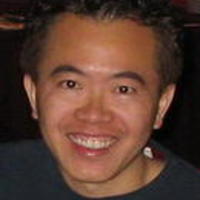
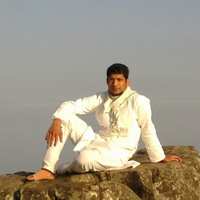

Uploads
Papers by Jacob Scharcanski
images. A color image is represented by a vector field, and the color
image edges are detected as differences in the local vector statistics. These statistical differences can include local variations in color or spatial image properties. The proposed approach can easily accommodate concepts, such as multiscale edge detection, as well as the latest developments in vector order statistics for color image processing. A distinction between the proposed approach and previous approaches for color edge detection using vector order statistics is that, besides the edge magnitude, the local edge direction is also provided. Note that edge direction information is a relevant feature to a variety of image analysis tasks (e.g., texture analysis) .
images. A color image is represented by a vector field, and the color
image edges are detected as differences in the local vector statistics. These statistical differences can include local variations in color or spatial image properties. The proposed approach can easily accommodate concepts, such as multiscale edge detection, as well as the latest developments in vector order statistics for color image processing. A distinction between the proposed approach and previous approaches for color edge detection using vector order statistics is that, besides the edge magnitude, the local edge direction is also provided. Note that edge direction information is a relevant feature to a variety of image analysis tasks (e.g., texture analysis) .